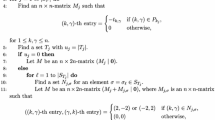Abstract
As far as we know, there is no decoding algorithm of any binary self-dual [40, 20, 8] code except for the syndrome decoding applied to the code directly. This syndrome decoding for a binary self-dual [40, 20, 8] code is not efficient in the sense that it cannot be done by hand due to a large syndrome table. The purpose of this paper is to give two new efficient decoding algorithms for an extremal binary doubly-even self-dual [40, 20, 8] code \(C_{40,1}^{DE}\) by hand with the help of a Hermitian self-dual [10, 5, 4] code \(E_{10}\) over GF(4). The main idea of this decoding is to project codewords of \(C_{40,1}^{DE}\) onto \(E_{10}\) so that it reduces the complexity of the decoding of \(C_{40,1}^{DE}\). The first algorithm is called the representation decoding algorithm. It is based on the pattern of codewords of \(E_{10}\). Using certain automorphisms of \(E_{10}\), we show that only eight types of codewords of \(E_{10}\) can produce all the codewords of \(E_{10}\). The second algorithm is called the syndrome decoding algorithm based on \(E_{10}\). It first solves the syndrome equation in \(E_{10}\) and finds a corresponding binary codeword of \(C_{40,1}^{DE}\).
Similar content being viewed by others
References
Aguilar-Melchor C., Gaborit P., Kim J.-L., Sok L., Solé P.: Classification of extremal and \(s\)-extremal binary self-dual codes of length \(38\). IEEE Trans. Inf. Theory 58(4), 2253–2262 (2012).
Bachoc C., Gaborit P.: On extremal additive GF\((4)\)-codes of lengths \(10\) to \(18\). J. Théor. Nombres Bordx. 12, 225–272 (2000).
Betsumiya K., Harada M., Munemasa A.: A complete classification of doubly even self-dual codes of length 40. Electron. J. Comb. 19(3), #P18 (2012).
Bouyuklieva S., Bouyukliev I., Harada M.: Some extremal self-dual codes and unimodular lattices in dimension 40. Finite Fields Appl. 21, 67–83 (2013).
Buyuklieva S., Yorgov V.: Singly-even self-dual codes of length 40. Des. Codes Cryptogr. 9, 131–141 (1996).
Calderbank A.R., Rains E.M., Shor P.W., Sloane N.J.A.: Quantum error correction via codes over GF(4). IEEE Trans. Inf. Theory 44, 1369–1387 (1998).
Conway J.H., Sloane N.J.A.: A new upper bound on the minimal distance of self-dual code. IEEE Trans. Inf. Theory 36, 1319–1333 (1990).
Danielsen L.E., Parker M.G.: On the classification of all self-dual additive codes over GF(4) of length up to 12. J. Comb. Theory Ser. A 113(7), 1351–1367 (2006).
Gaborit P., Huffman W.C., Kim J.-L., Pless V.: On the classification of extremal additive codes over \(GF(4)\). In: Proceedings of the 37th Allerton Conference on Communication, Control, and Computing, UIUC, pp. 535–544 (1999).
Gaborit P., Huffman W.C., Kim J.-L., Pless V.: On additive \(GF(4)\) codes. In: Barg, A., Litsyn, S. (eds.) Proceedings of the DIMACS Workshop on Codes and Association Schemes. DIMACS Series in Discrete Mathematics and Theoretical Computer Science, vol. 56, pp. 135–149. American Mathematical Society, Providence (2001).
Gaborit P., Kim J.-L., Pless V.: Decoding binary \(R(2,5)\) by hand. Discret. Math. 264, 55–73 (2003).
Harada M., Munemasa A.: Some restrictions on weight enumerators of singly even self-dual codes. IEEE Trans. Inf. Theory 52, 1266–1269 (2006).
Höhn G.: Self-dual codes over the Kleinian four group. Math. Ann. 327, 227–255 (2003).
Huffman W.C.: On the classification and enumeration of self-dual codes. Finite Fields Appl. 11, 451–490 (2005).
Huffman W.C., Pless V.: Fundamentals of Error-Correcting Codes. Cambridge University Press, Cambridge (2003).
Joyner D., Kim J.-L.: Selected Unsolved Problems in Coding Theory. Birkhäuser, Boston (2011).
Kim J.-L., Mellinger K.E., Pless V.: Projections of binary linear codes onto larger fields. SIAM J. Discret. Math. 16(4), 591–603 (2003).
MacWilliams F.J., Odlyzko A.M., Sloane N.J.A.: Self-dual codes over \(GF(4)\). J. Comb. Theory, Ser. A 25, 288–318 (1978).
Pless V.: A classification of self-orthogonal codes over GF(2). Discret. Math. 3, 209–246 (1972).
Pless V.: Decoding the Golay codes. IEEE Trans. Inf. Theory 32, 561–567 (1986).
Rains E.M., Sloane N.J.A.: Self-dual codes. In: Pless, V.S., Huffman, W.C. (eds.) Handbook of Coding Theory, pp. 177–294. Elsevier, Amsterdam (1998).
Acknowledgments
J.-L. Kim was supported by Basic Research Program through the National Research Foundation of Korea (NRF) funded by the Ministry of Education (NRF-2013R1A1A2005172).
Author information
Authors and Affiliations
Corresponding author
Additional information
Communicated by C. Mitchell.
Rights and permissions
About this article
Cite this article
Kim, JL., Lee, N. A projection decoding of a binary extremal self-dual code of length 40. Des. Codes Cryptogr. 83, 589–609 (2017). https://doi.org/10.1007/s10623-016-0253-0
Received:
Revised:
Accepted:
Published:
Issue Date:
DOI: https://doi.org/10.1007/s10623-016-0253-0



